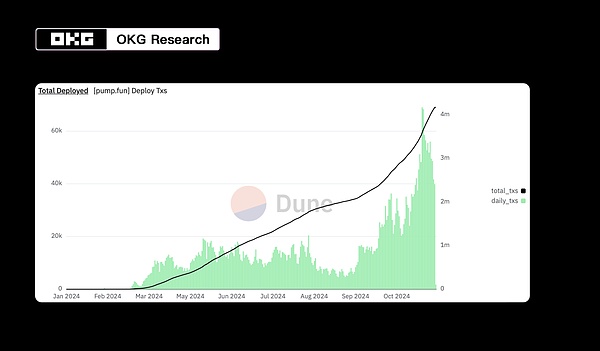
Author: Samuel QIN
Recently, the Web3 project Pump.Fun has once again attracted the attention of the industry: its application to Kraken SOL worth more than 22.74 million US dollars has been transferred, and has shown a steep upward growth trend since September. So far, the project has accumulated revenue of more than 1.5 million SOL (calculated at the current SOL price, the profit exceeds 300 million US dollars). The meme trend is booming, with numerous stories about wealth survivorship bias flooding various channels, and Pump.Fun is the epitome of this “war for attention.”
The success of Pump.fun can be said to a certain extent to be the continued manifestation of the attention economy in the Web3 industry.
In the world of Web3, Meme is no longer just a symbol of Internet culture, but combined with the token economy, it has become a powerful economic tool.
Especially with the support of Pump.fun, you only need a picture, a name, and a small platform fee to complete all deployments. Currently, Over 4 million tokens deployed. Any idea in a user's mind can become a token within 5 minutes. Any popular topics, labels, and cultural symbols can undoubtedly enhance the communication effect.
Photo Source: OKG Research, https://dune.com/hashed_official/pumpdotfun
In this way, the binding relationship between hot spots and user attention is strengthened, and market sentiment can change with the popularity of the event itself. To this end, Pump.Fun launched a live broadcast function in an attempt to further attract attention through real-time interaction. But then, in order to gain more attention, the live broadcast content of various blogs caused controversy, and the live broadcast function had to be temporarily removed from the shelves. Similar to traditional Web2, various blogging events may be followed by live sales of goods. Pump.fun further compresses this process and successfully converts attention into economic value directly through Crypto.
In addition, the fair launch model does not have pre-sales or team reserved shares, and there is no VCBlessing, the "frank way" of telling everything in detail also sheds light on the conflicts between ordinary investors and institutions this year.
At the same time, the threshold for Web3 currency issuance is also further lowered. Take Clanker as an example, which is a Base-based AI Agent. Users can generate Meme tokens with simple text interaction in Farcaster. This kind of gameplay significantly lowers the threshold for participation, allowing more people to easily enter Meme’s “wealth-making track.” The lowering of the threshold has also brought about another significant problem: the dilution of cultural attributes and the strengthening of commercialization.
The hidden worries of the PVP game mode—strengthening the narrative or amplifying risks?
This extreme attention economy is also mainly reflected in the strengthening of the PVP game mode. Meme tokens have shown amazing effectiveness in attracting users through the narrative of “increases to convince people.” The hidden concern is that this attention-driven model will invisibly amplify risks, and the market volatility and possibility of manipulation will significantly increase. In this environment, users may be coerced into high-risk speculation, only to be left with nothing once the heat dissipates.
Metamask's Co-founder Dan Finlay also said after recently conducting Memecoin launch experiments on Sol and Base: The concept of individual issuance or Meme tokens is being implemented correctly. It may be useful in the future, but the current lack of consensus hinders the effectiveness of Memecoin in empowering the ecosystem. He called for clearer mechanisms and better systems to improve user experience and community trust.
Ecological empowerment beyond Meme business
The Meme economy is so profitable, but this Can the business serve the subsequent Web 3 ecosystem?
Just like the gold-mining craze that set off in the American West, it was often the people who sold water and shovels who made the money in the end. The craze for Meme tokens may just be a carnival for a few projects and tool platforms, while the real ordinary participants are likely to become the ones being harvested in this economic game.
For the Meme economy to transcend short-term traffic play and become an ecological force that is truly beneficial to the development of Web3, the industry needs more thanIt’s not just the ability to attract attention, but also thinking about how to turn attention into long-term value. The attention economy is a tool, not an end. What really determines the future of Web3 is not the Meme that attracts fans, but whether the Meme business can build a healthier and more sustainable ecosystem. The next wave of craze is coming. Will you choose the Nuggets or sell shovels?












